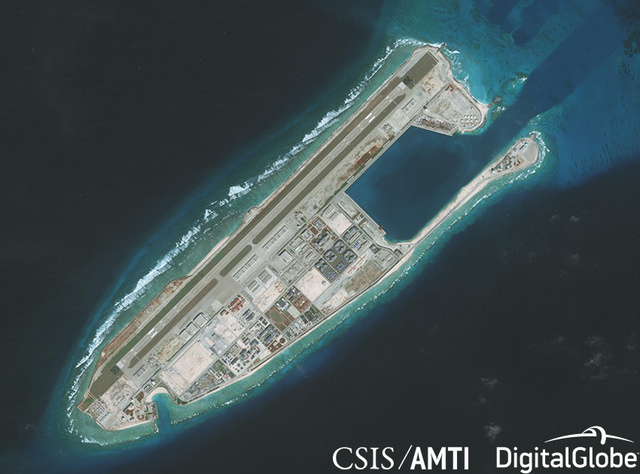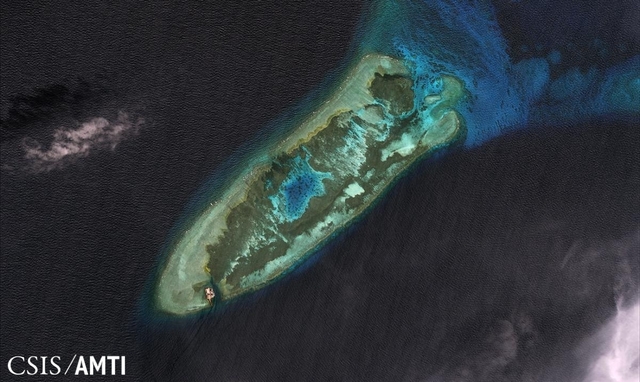The routine presence of Chinese military assets shows Beijing's continuing dominance in the West Philippine Sea

KAGITINGAN REEF. This satellite image dated January 1, 2018, shows Kagitingan Reef (Fiery Cross Reef) in the West Philippine Sea (South China Sea). Photo courtesy of CSIS/AMTI/DigitalGlobe
A Chinese military plane landed on Kagitingan Reef (Fiery Cross Reef) in the West Philippine Sea on Saturday, March 28, a satellite image showed.
In a tweet on Sunday, March 29, the Israel-based satellite imaging service company ImageSat International said a Chinese military Y-8 transport aircraft landed on the artificial island, "probably bringing supplies."
"Routine operation of transport aircraft in the South China Sea area could indicate that the Chinese military is hardly affected by the country's health crisis," ImageSat said in the tweet.
The West Philippine Sea is the Philippines' exclusive economic zone and outlying areas it claims as territory within the larger South China Sea.
Kagitingan Reef, formerly a submerged maritime feature, is also claimed by China, Taiwan, and Vietnam. Since 2015, it has been reclaimed and transformed by China into a military base, complete with a 3-kilometer runway worthy of fighter jets, a harbor for naval vessels, missile systems, hangars, and a scientific research station.
It is one of 7 reefs in the Spratly group of islands that China has reclaimed and militarized.
China recently opened a research station on Kagitingan and Zamora Reef (Subi Reef), also in the West Philippine Sea, to gather data on the ecology, geology, and environment in the Spratlys, which includes what the Philippines calls the Kalayaan Island Group.
A United Nations-backed arbitral tribunal ruled in July 2016 that China's sweeping 9-dash line claim in the South China Sea is illegal, and that the Philippines is entitled to sovereign rights in the West Philippine Sea.
But China has proceeded to develop the reclaimed islets despite calls from the international community for it to desist, especially in putting military installations that heighten tensions with other claimant states like the Philippines.

ORIGINAL STATE. This was Kagitingan Reef (Fiery Cross Reef) before China started reclaiming it in 2015. Photo from CSIS-AMTI
In a tweet on Sunday, March 29, the Israel-based satellite imaging service company ImageSat International said a Chinese military Y-8 transport aircraft landed on the artificial island, "probably bringing supplies."
"Routine operation of transport aircraft in the South China Sea area could indicate that the Chinese military is hardly affected by the country's health crisis," ImageSat said in the tweet.
The West Philippine Sea is the Philippines' exclusive economic zone and outlying areas it claims as territory within the larger South China Sea.
Kagitingan Reef, formerly a submerged maritime feature, is also claimed by China, Taiwan, and Vietnam. Since 2015, it has been reclaimed and transformed by China into a military base, complete with a 3-kilometer runway worthy of fighter jets, a harbor for naval vessels, missile systems, hangars, and a scientific research station.
It is one of 7 reefs in the Spratly group of islands that China has reclaimed and militarized.
China recently opened a research station on Kagitingan and Zamora Reef (Subi Reef), also in the West Philippine Sea, to gather data on the ecology, geology, and environment in the Spratlys, which includes what the Philippines calls the Kalayaan Island Group.
A United Nations-backed arbitral tribunal ruled in July 2016 that China's sweeping 9-dash line claim in the South China Sea is illegal, and that the Philippines is entitled to sovereign rights in the West Philippine Sea.
But China has proceeded to develop the reclaimed islets despite calls from the international community for it to desist, especially in putting military installations that heighten tensions with other claimant states like the Philippines.

ORIGINAL STATE. This was Kagitingan Reef (Fiery Cross Reef) before China started reclaiming it in 2015. Photo from CSIS-AMTI
The presence of Chinese vessels and other assets in the West Philippine Sea is seen by experts as a gray zone tactic by which China dominates what ought to be an international sea lane without sparking overt armed conflict with rival claimants.
Around the Philippine-held Pag-asa Island (Thitu Island) near Zamora Reef, hundreds of Chinese fishing vessels have lingered since December 2018, hardly doing any fishing. Experts and even some Philippine officials believe the boats are militias sent by Beijing to occupy and assert its presence in the area.
Under President Rodrigo Duterte, the Philippines has toned down asserting its claim over the West Philippine Sea, as Duterte seeks to broaden political and economic ties with China.
https://www.rappler.com/nation/256421-satellite-image-shows-chinese-military-plane-kagitingan-reef-march-2020
Around the Philippine-held Pag-asa Island (Thitu Island) near Zamora Reef, hundreds of Chinese fishing vessels have lingered since December 2018, hardly doing any fishing. Experts and even some Philippine officials believe the boats are militias sent by Beijing to occupy and assert its presence in the area.
Under President Rodrigo Duterte, the Philippines has toned down asserting its claim over the West Philippine Sea, as Duterte seeks to broaden political and economic ties with China.
https://www.rappler.com/nation/256421-satellite-image-shows-chinese-military-plane-kagitingan-reef-march-2020

No comments:
Post a Comment
Note: Only a member of this blog may post a comment.